#Zesk
Text

Zesk Drone
Intelligence and bling.
Source
Creator: Antak3000
#lego#bionicle#armor#armor plates#zesk#bara magna#quadruped#beast#bestial#gold#golden#golden armor#fangs#teeth#big teeth#tail#long#long tail#scorpion#scorpion tail#claws#mandible#sand#sand tribe#power armor
31 notes
·
View notes
Text
thinking about spherus magna so so so much and i NEED to write about the tribes and their bodies and their eating habits
to start off - agori and glatorian are like dogs and wolves: same progenitor, compatible to create hybrids capable of reproduction, different appearances and strengths but similar genetic curriculum.
the seven tribes have specific differences in appearance but most of their anatomy is still the same - humanoid, sharp spaced teeth, vestigial minuscule stubby tail, flat nose, small ears. cross-tribe children weren't very common before the shattering (big ass planet and all) and might become more common as time passes (lots of people died and whatnot), but due to there being no real hierarchy in the gene pool they wont necessarily be perfect hybrids of their parents: more often than not they will resemble only one of them, or showcase smaller traits of the other.
Tapyri (Fire tribe) - oval pupils stretched horizontally, tough skin that secretes a layer of protective mucus good for hot dry climates. different skin pigmentation in the form of spotted patterns, mostly on the back, is surprisingly common.
Gaquri (Water tribe) - crescent pupils stretched horizontally, drop-shaped sturdy scales that slightly overlap. hands and feet are lightly webbed between their fingers, while the eyes have a protective lid for underwater diving.
Lebori (Jungle tribe) - beaded pupils stretched vertically, short thin feathers, mostly greenish, which generally have little use. fingertips, palms and soles have small hooked cells to better their grip when climbing trees and rocks.
Koniri (Ice tribe) - rhomboidal pupils stretched vertically, thick fur that sheds and changes color depending on the seasons. powerful nails and bite, build up fat much easier than other tribes and are incredible sprinters on short distances.
Banuri (Sand tribe) - slit pupils stretched vertically, very small polygonal scales tightly placed together. small sharp horn-like protrusions all over the body, mostly the head, and remarkable adaptability to varying temperatures.
Potori (Rock tribe) - rectangular pupils stretched horizontally, wooly fur that varies in thickness depending on place of origin*. duller teeth, immune to most poisons, have heightened endurance in harsh climates and tougher bones.
Fezeri (Iron tribe) - round pupils similar to a photocamera's aperture, sectioned carapace not unlike that of an insect over skin. have a tendency to develop reddish crusts with age which need to be removed through cyclical moltings.
when it comes to food. oh baby.
ANY CREATURE in the desert is fair game. theyre most of the meat available and by god these people will Fucking Get It or die trying. blood is both cooked and drunk (usually on special occasions) and is often given to sickly, pregnant or young individuals; bones are generally split open for marrow, but while smaller ones can be grated or used to make stock broth, the bigger ones are kept to make weapons or tools - the only ones that eat them are the Bone Hunters, which is why they're called that in the first place, and the Zesk and Vorox, who have built in weapons.
Tapyri have very fertile soil but horrendously high temperatures, so they can grow only a select few plants, mostly cereals. common foods are iron snails and a type of edible lava residue, but a real delicacy is the elusive heat-resistant mole, which is incredibly fat and tender but also fucking FAST. they cook mostly on slabs of rock heated over lava, or on roasts
Gaquri eat anything that enjoys humidity - slugs, leeches**, tadpoles, frogs, other small amphibians, fish and crustaceans if they had any. their vegetables are cave mosses and freshwater algae or kelps - a specific type produces "kelp jades", round fruits that are sticky as hell. they tend to eat things raw, but can also afford to steam or boil their stuff
Lebori have the vastest array of fruits and greens available thanks to living in the green lung of a fucking desert and everybody imports that good stuff from them. their local protein source is comprised mostly insects***, worms and other invertebrates, which they employ in various methods. since they have access to oil, they often default to frying food
Koniri have access to small game and a discrete amount of forests in which they've learned to recognize edible berries, leaves and especially branches. a typical dish for them is a bundle of sticks wrapped in very far strips of meat. in some lakes they also harvest a strange type of anemone. when they don't freeze-dry their food, they tend to either boil or roast it
Banuri relied evenly on hunting, gathering, and husbandry. Zesk and Vorox have adapted thoroughly to the desert ecosystem, and while the first still gather lichens, the latter most hunt in packs
Bone Hunters, being scavengers, eat anything and everything; the Skrall had a more plant-based diet, but in Bara Magna added salt-dried meat; other Potori prefer vegetables like briars and thistles
Fezeri lived in fairly comfortable climates and could afford a pretty varied and balanced diet. Telluris allegedly eats, but nobody can confirm. Sahmad is trying to fuckin survive. give him a break
*Bone Hunters, native to the Bara Magna area, resemble goats; the Skrall, native to a snowy mountain area, resemble sheep. similar cases are found in all tribes across Spherus Magna (ex. BaMa lebori are more akin to geckos, BoMa lebori to lemurs)
**Gaquri would, as such, be the first to try and eat a kraata or krana without even thinking about it. the consistency would not bother them, but they would be mostly perplexed to discover there's food that tastes, respectively, "dark" and "bright"
***scarabax beetles not included, because they taste horribly and are not worth the effort of catching to feed off of them for anybody. Click will live forever
#bionicle#spherus magna#bara magna#agori#glatorian#skrall#bone hunters#zesk#vorox#random talks#hi. it is currently (looks at clock) Fuckin Late. and i just discovered that the prefix for gravity is ba- and for magnetism is fa-#i think i got most of my thoughts out of myself#apart from various physical reactions for the tribes BUT. i am. tired.#i also have Thoughts on food in the matoran universe and stuff but thats for!!!! another day#in the meantime. have this. if you would
24 notes
·
View notes
Text

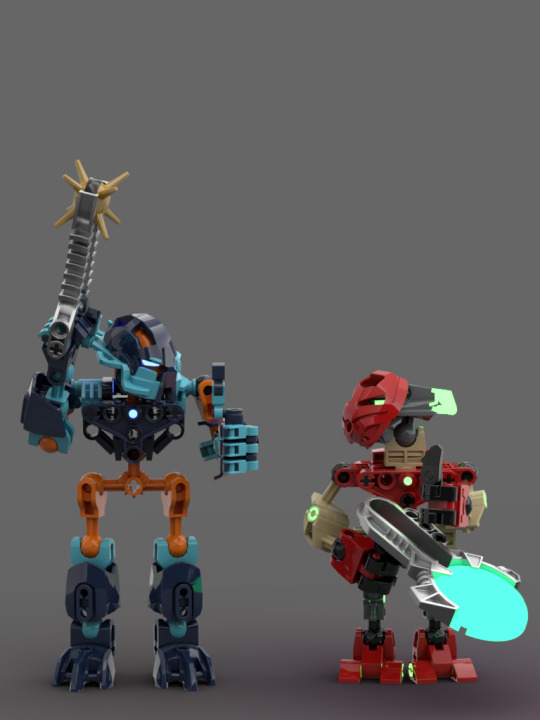



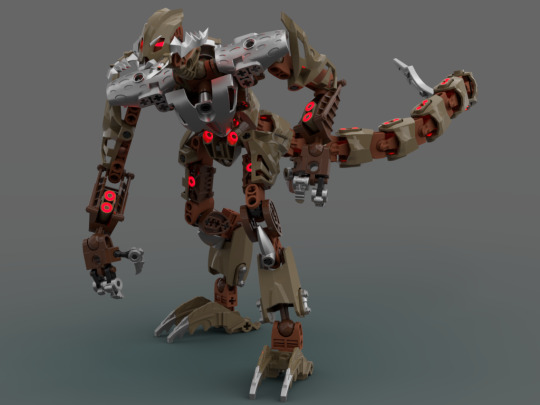

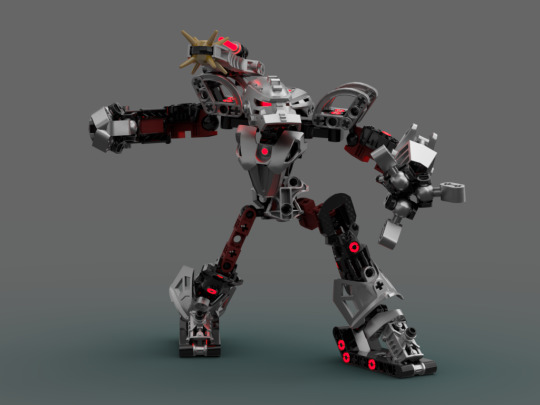

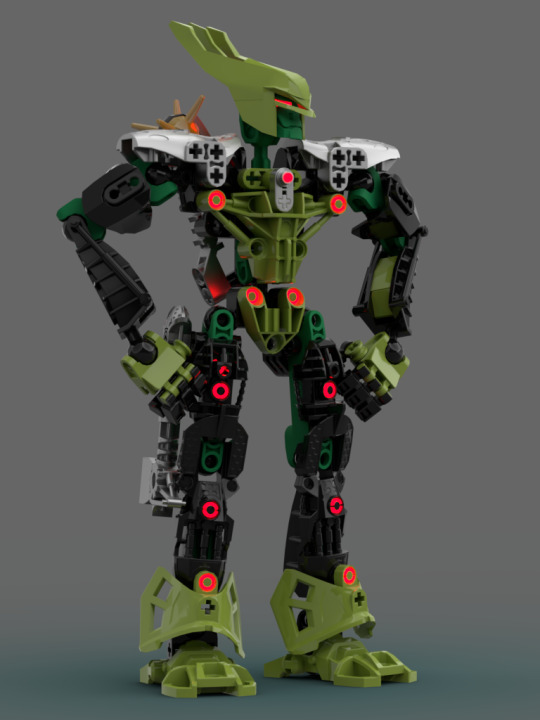
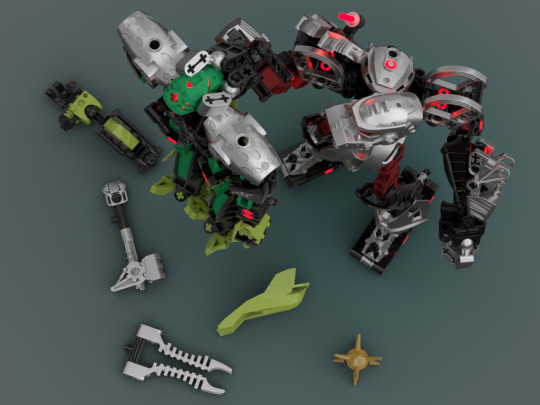


Been giving the 'Matoran Universe' side of things a lot of attention, so decided to give the non MU side of things some love.
The Agori
The Natives of Spherus Magna, and later Bara Magna after the Shattering. They are a race of hardy organic beings with naturally metallic skeletons. they are exceptionally long lived, which is only further enhanced by the common use of cybernetic implants in the race.
They are divided into various Tribes across the world, each taking a name relevant to an element important to their society, or naming themselves after where they live.
Zesk
A sub-race of Agori, and all that remains of the Sand Tribe. They were modified by the Great Beings into a more beastial form, and slowly over time devolved into little more than animals. Most Zesk however, are able to be acclimated into civilized society under the right circumstances.
Glatorian
A species of beings closely related to the Agori, but larger and stronger. They often live in the Triebs alongside Agori. After the Shattering, Glatorian picked up the role of protectors of the Agori. They protected their younger relatives from the various threats of Bara Magna.
Eventually, as things settled and resources began to dwindle, wars broke out amongst the Agori, Glatorian, and the Skrall. Eventually, things settled with the creation of the Glatorian Arenas. Glatorian would fight in the arenas to earn resources for their Tribes.
Though Glatorian is traditionally the name of a race, it has since evolved into a title as well. Anyone who fights in a Glatorian Arena earns the title of Glatorian, regardless of what they are. Agori, Skrall, Matoran, Toa, etc.
Vorox
Similar to the Zesk, the Vorox were Glatorian of the Sand Tribe, modified by the Great Beings. Like their smaller cousins, the Vorox devolved into aggressive desert wondering animals. They too can be acclimated into society, but doing so is much more difficult due to their enhanced strength and durability.
Skrall
Another close relative of the Agori and Glatorian, though distinct, the Skrall are a race of strong and durable people. They live alongside Agori in the Stone Tribe.
Skrall culture is rather violent, more so than Agori and Glatorian culture. In recent years however, after the Reformation things have begun to mellow out however. Even before then, many individual Skrall have incorporated themselves into other tribes.
Kaadrix is one such Skrall. He was exiled from the Stone Tribe before the Reformation. He wandered alone for a long time, before finding a tribe called the Mountain Tribe. He was able to incorporate himself into the tribe.
Koza is a Skrall warrior that has heavily modified himself through cybernetics. He is much stronger than most other Skrall. He's infamous for his brutality in the Arena, having torn another Glatorian by the name of Telrakk apart.
Gelra a Glatorian of the Water Tribe. She's a strong, burly warrior with an ego to her. She's well known for her outstanding strength, surprisingly able to match Koza in hand to hand combat on numerous occassions, and typically choosing to fight other Glatorian who are using vehicles or mounts.
Telrakk was an up and coming Glatorian for a branch of the Jungle Tribe. He suffered a particularly nasty loss at the hands of Koza, leaving him severely injured. Eventually, much of body was replaced by mechanics as a result. Over time his off shoot of the Jungle Tribe would run into hardship with Bone Hunters, and during a rematch with Koza, his Tribe's home was razed by the bandits. His return to his destroyed home lead him to become
Talrakk the Conqueror an infamous warlord who uses engineered robots as his army. He intends to conquer as much of the Spherus Magna as he can to forcefully protect it from outside threats with his mechanical troops.
#Bionicle#Bionicle Moc#lego#lego moc#Glatorian#Agori#Zesk#Vorox#Skrall#Fire tribe#Water Tribe#Sand Tribe#Jungle Tribe#Mountain Tribe#Stone Tribe#Ice Tribe
64 notes
·
View notes
Text
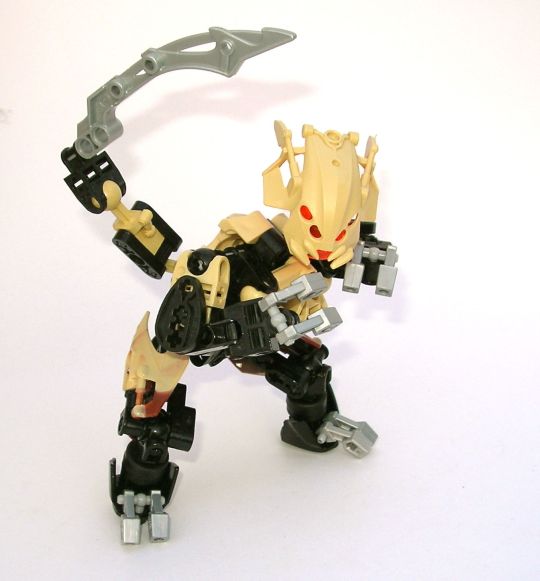

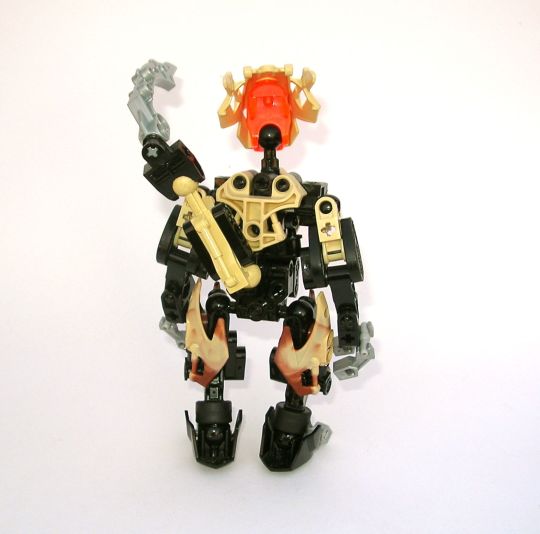
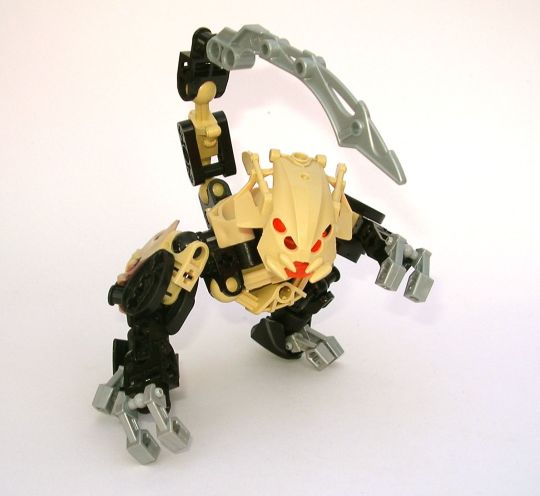
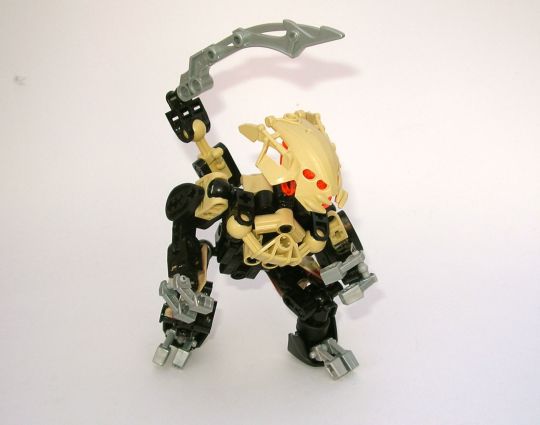






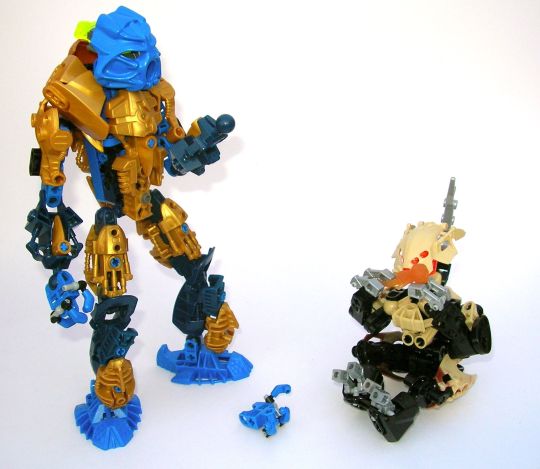
Chiana (2012)
Originally built as a request by Jadekaiser, this character was intended to be a female member of the Zesk species.
The last panels show some sort of comic which used to have a narration that's now long lost on the old MOCpages servers. She apparently wanted to eat a squid and, during the conquest, took off Range's hand. Fascinating.
47 notes
·
View notes
Text



Vraaski and Suletox of the Sand Tribe
Aqua Magna, c. 100,000 AGR
In the past millennia, the sand tribe has gradually regained interest in communicating and collaborating with the rest of the world, and have abandoned some (though not all) of the traits that once caused other agori to view them as bestial. Past animosities have largely been left behind on the grand scale of things. They even accept and raise biomech members just like their fellow tribes. To the villagers of Meki Nui, Vraaski and Suletox are perhaps some of the most familiar members of the sand tribe settlement on the island's southeastern beach. They are glad to sell the raw materials they comb from the beach and salvage from the ocean to anyone with the widgets.
Moctober 2022, day 13
#lego#bionicle#moc#stud.io#moctober#moctober 2022#matoran#agori#zesk#meki nui#sand tribe#vraaski#suletox#yeah i know one of vraaski's arms is longer than the other it's a mistake#i didn't feel like going back and redoing the render
64 notes
·
View notes
Text
2003, 2006, and of course 2010 are, to my knowledge, the only years in all of Bionicle's runs(s) in which a set featuring a stinger tail, counting combination and alternate models, was not produced
#bionicle#stinger tails#beware them#nui-jaga#kofo-jaga#bionicle master builder set#kralhi#zivon#mantax#hydruka#niazesk#zesk#vorox#fero and skirmix#skopio xv-1#pohatu - master of stone#protector of stone#skull scorpio#ketar - creature of stone#2008 i suppose is debatable#niazesk's 'stinger tail' is arguably more of a thorax#though there is also a case to be made for 2006#given that was the year the dark hunter guidebook released#which featured multiple characters with stinger tails#(they weren't sets of course but they were still revealed in 06)
11 notes
·
View notes
Text
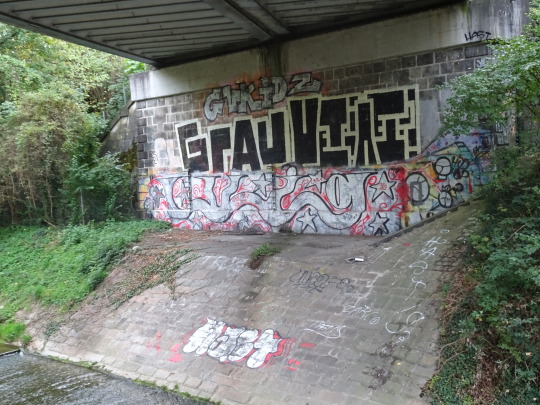
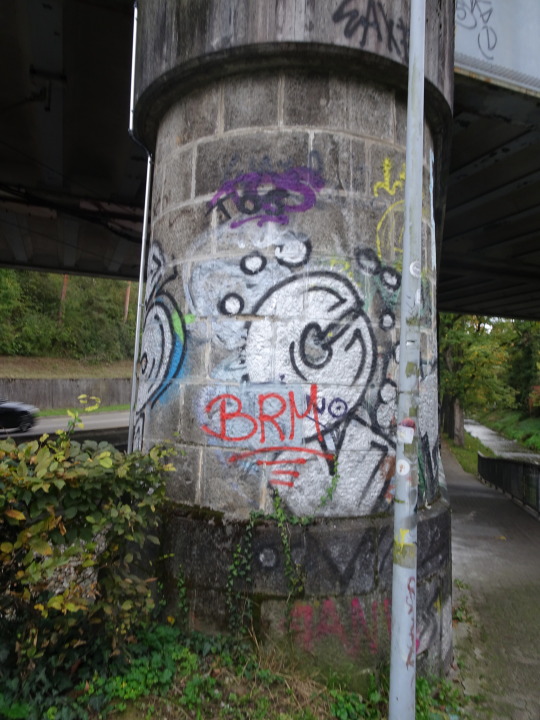

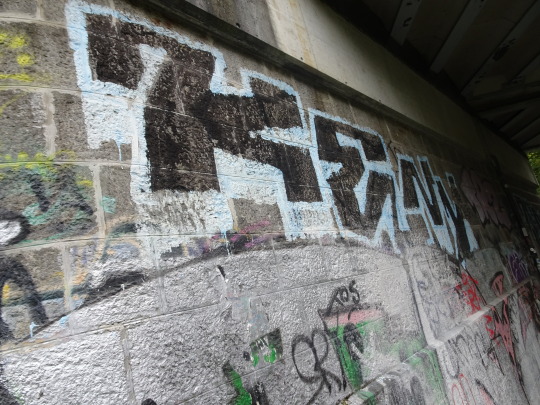
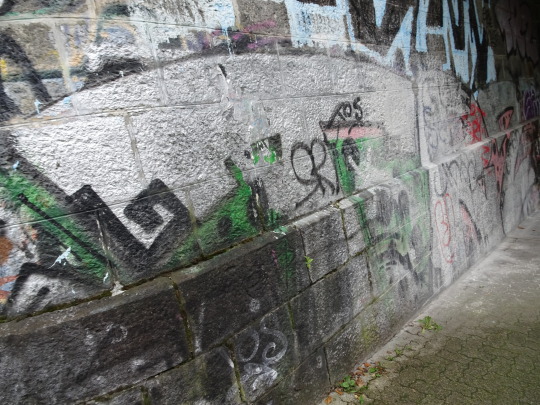

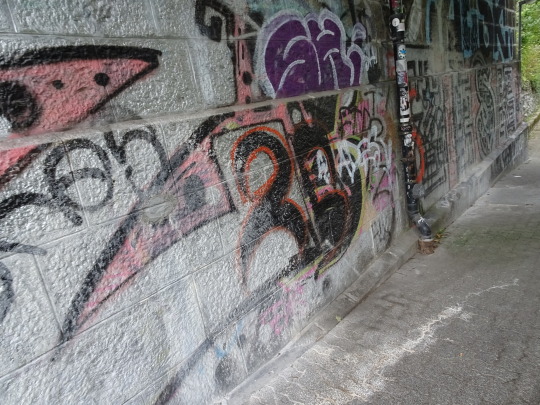

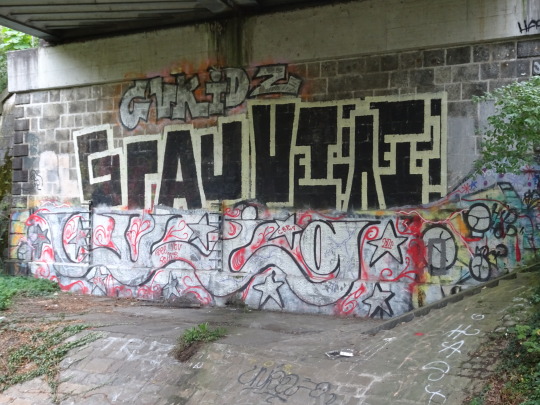
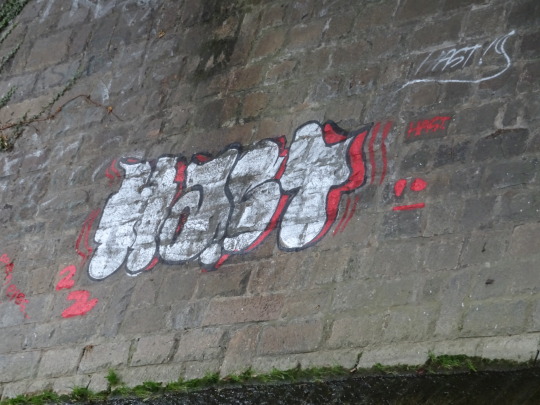
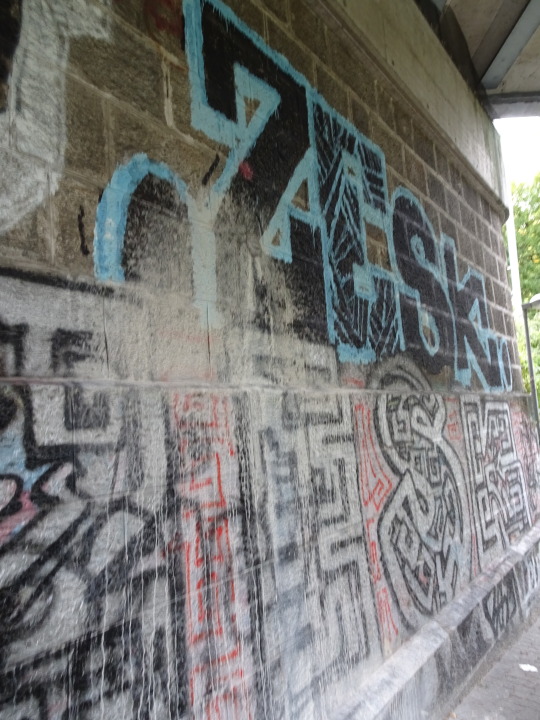

Basel, Switzerland, October 2022
8 notes
·
View notes
Text
Nooo! THE divorce happened! I can't believe it! 😭😭😭 The love is dead! 😭😭😭


#this is obviously sarcasm everyone#and with everyone i mean the people who will need to touch grass#im still laughing over the fact that putler thought this is worth telling the press#he really thinks he did something there#bro buddy putler#thats not the flex or story to make you look you think it is#on another note#who would have thought at the beginning of the year that scholz and macron are actually going to be good political boyfriends#and nauseda would appear as the new number 1 support political boyfriend#and that duda is cancelled#it was a wild year#btw so far i only saw good stuff about tusk SO I AM READY FOR ZESK OKAY#or vosk?#or tuze?#tuvo?#we need a name
24 notes
·
View notes
Text







On some cold Bara Magna nights, you can spot a lone figure wandering through the wastes. Camoflagued against the dunes if it weren’t for the metal carapace mounted on top of its somewhat bestial body reflecting the stray beams of starlight. Also followed with it is a strange smell that only the oldest seem to recognize. Protodermis, they call it.
Is it a Vorox? Couldn’t be, rumors are that some have seen it scaring off Zesk as if it was afraid of them. The Zesk still curiously follow it around wherever it goes.
Is he a Glatorian then? There was one instance where he wandered too close to Vulcanus, and Batalux the Outsider challenged him to a duel. He won quite handily, despite the brute strength of Batalux. Once he got close enough his strange weapon wrapped itself around Batalux’s neck as if it had a mind of its own, and could only be separated after a hoard of Agori declared the fight dishonorable and started pelting the stranger with rocks. Batalux took a very long time to regain his strength, as if he had been poisoned.
It should also be noted that the stranger made no demands or arguments to the Agori after the duel ended. He simply walked away in silence. Whatever his goals were that night, they were reached.
When another stranger appeared on Bara Magna, known as Mata Nui, sightings of this odd individual increased substantially. They never met directly, but in the commotion that followed where Mata Nui went, the stranger could often be seen observing him with a queer fascination, and perhaps familiarity?
The last known sighting of this odd individual before the Battle of Bara Magna and the reformation of Spherus Magna was when a lone Agori stumbled upon him in the outskirts of the combined villages. He was holding a small object in his hands, almost like a Glatorian helmet, but different. Before the agori ran from the dangerous individual he was also heard speaking for the first time on record, only uttering three words.
“Soon, Velika. Soon.”
My latest moc, Escaenon (he/it). A Great Being in hiding on Bara Magna. A specialist in organic engineering with a murky history in the former Sand tribe.
56 notes
·
View notes
Text
New self moc time!!

This is Kytera, a Zesk from Bota Magna, credit to @karyot for the chest build and fancy render!
150 notes
·
View notes
Text
woe/rejoice. agori (and by extension glatorian) hcs be upon you
Agori exhibit subtle sexual dimorphism differently depending on which tribe they belong to (i.e. lebori males have brighter plumage, fezeri females are larger), while their bone structures are essentially identical. Gaquri are the only tribe able to naturally alter their bodies' production of their estrogen and testosterone equivalents. Actively transitioning and/or intersex individuals of any tribe can present dimorphic traits of one sex, traits of both sexes, muddled traits, or none at all
Their breasts are placed in the pelvic area, like horses, and the nips are the only visible part. To prevent chafing, lower garments have soft reinforcements at hip-height
They have short, nubby tails which have survived across their evolution despite having lost their original size and purpose. their movement is very limited and usually unconscious; since they remain the same length during all stages of life, they appear to "shrink" the more a person grows. children use them to better balance themselves when learning to walk
With the exception of Basari's and Fezeri's, Agori ears are very flexible despite their small size and can lean in almost all directions. Their shape varies across tribes
Their senses aside from touch are generally keener than humans'
Agori clothing tends to prefer function to form and does not have significant differences between masculine and feminine styles, although it wasn't always the case before the Shattering
Together with hugs, kisses and handshakes, each tribe has a unique display of affection or greeting pertaining to the head and/or face: Lebori preen each other, Gaquri rub cheeks together, Koniri gently nip ears, Fezeri butt the top of their heads, Basari scratch each other's nape, Potori shove temples against one another and Tapyri press the other's hand to their forehead. The gesture's intensity is usually toned down when done to someone of a different tribe to avoid discomfort or pain
If an object is in an enclosed space like a house, a vehicle or a box, Agori will point to it with their chins instead of their fingers
Vorox and Zesk still communicate in an extremely simplified version of a strict Basari dialect, although the phonetics had to be heavily changed to adapt to the shape of their mutated mouths. Malum has learned it and is currently the only fully sapient being somewhat fluent in Bara Magna Basari
Other tribes tend not to know Tapyri have hair
Koniri fur keeps warm, but becomes stiff in great quantities; Lebori down feathers are very soft, but struggle to retain heat on their own; Potori wool offers great insulation in most climates, but risks growing mold easily when humidity increases
After they (almost) went extinct, the sturdy carapaces of dead Bara Magna Fezeri were pillaged to make very durable high quality armor. because of this there are no intact pieces or Fezeri remains left, and the few plates that have survived since, no matter how worn or outright broken, are either made into family heirlooms or sold at exhorbitant prices. Sahmad has a large number of them (almost all buried) as he made a habit of targetting and capturing anybody who wore them specifically
Tapyri are unique when it comes to cleaning since their protective mucus naturally catches dirt and other particles for easy removal, meaning they only need to scrub or peel it off. Gaquri, Koniri and Potori take water baths while Basari, Fezeri and Lebori take dust or sand baths
Agori children are addressed with the pronouns ti/tir until they choose their own. its highly unusual for someone to use ti/tir for tir whole life, and the set is often used as a playful jab when a person exhibits childish behavior
Pregnancy is a very taxing endeavour: the process takes around a year and a half, but the parent's body will additionally need two or three years to recover from the strain of the experience as a whole, during which it will be physically unable to produce the necessary material to make another child. sudden spikes in stress or a constant stream of it during pregnancy is almost sure to produce a stillborn, and its very easy for older individuals to simply not have the energy to make it through childbirth once the time comes. this used to not be a problem, since Agori are very long lived and the whole planet was full of them, but the Core War drastically reduced their numbers and the hazardous conditions produced by the Shattering all over the planet made for a very dangerous environment to attempt having a child in, so births became extremely rare in the 100 thousand years before Mata Nui's return. the so called "children of Bara Magna" (which include Gresh and Berix) are few and far between, commonly having significant age gaps from one to the other
A wide number of male MU beings is perceived as feminine or adjacent by Agori, partly due to sexual dimorphism not being A Thing for most species, partly due to voice and countenance: Tahu, for example, is considered to be very lady-like. in his specific case this perception might however be also affected by the fact that he was modeled after Ackar, who used to be much more overtly femme in his youth* (check tags)
this is what ive got so far. peace and love on spherus magna.
#bionicle#spherus magna#bara magna#agori#glatorian#random talks#(banging fists on the desk) its MY worldbuilding hc and i get to make EVERYONE FLAT CHESTED#a whole planet of sapient organic mammalian beings and the vortixx are STILL the only species with boobs. as it should be#a few of these traits are based on animals i.e. gaquri changing hormones is based on some fish being able to change sexes#ah yes. the Femme Bionicles. the angry fire poster boy and some old ass rugged desert warrior who just wants to retire#*by ackar being femme i dont mean 'he used to dress femininely' or 'he used to present femininely in ways humans might do'#i mean 'he exhibits very toned down male dimorphic traits for attracting mates bc hes ace and sure as plude not gonna want to attract Shit'#which resulted in his appearance being noticeably closer to that of female tapyri than that of other male tapyri#those traits end up becoming fainter with age anyways so now that hes older the difference is not as obvious#also bc its funny tarix still produces estrogen despite being a trans man just so he can give it to his trans wife vastus. homegrown hrt#vastus voice there are many benefits to being married to a fish#i probably forgot things. pester me about stuff you want to know or want elaborations on ig
32 notes
·
View notes
Text
Headcanon Ramblings: The BIO in Bionicle (Part 1, Reproduction and Infanthood)
Alright, I'm gonna ramble about how each species reproduces. Scientific and some mature topics incoming, including genital descriptions.
First of all, the canon info I'm working with:
Agori are mammalian, in the sense they have live-born. I expand this to presume pectoral lactation as well, large-gamete-female and small-gamete-male, etc.
Skakdi are more organic than anything else in the MU, to the point that replacing body parts could be dangerous or fatal.
Second, a few clarifying things:
I use "Glatorian" to refer to the species. I'd make up a name for them, but this is easier for readers.
Elsewhere I put up my ramble about Bionicle timing. Generally, presume that if I use years, I am using them to compare to human development, using Matoran/Agori development as the default. In other words, a "2-year-old Matoran" is a Matoran who is cognitively similar to a 2-year-old human. A "2-year-old Makuta" is a Makuta the same chronological age as that Matoran, even though Makuta brains develop different parts at a different rate to a Matoran, etc.
Matoran, Vortixx, Skakdi, Toa, Makuta, etc, will be referred to as "Muians" or "MUians" (Matoran Universe-ians). Agori, Glatorian, Skrall, Bone Hunters, Vorox, Zesk, etc, will be referred to as "SMnans" (Spherus Magnans). Specifically, these are referring to only the sapient beings of this evolutionary line, so any time I say "All MUians" or "Of any species", for example, I'm not including, say, Tarakavas or Spikits. MUians and SMnans are biologically of the same "evolutionary line".
When the MUians were converted organic, the sexes were evened out. Many beings who had been programmed male were recreated biologically female. As gender had virtually no bearing on them beyond elements before, and "programmed male" just meant "programmed as less gentle" (according to Farshtey), this has caused minimal identity concerns.
Reproductive Anatomy

(A Photo of Lariska, pregnant with Zaani)
All Muians and SMnans reproduce the same way and have similar genitals and reproductive anatomy. Females contain large gametes, a uterus, two ovaries, and two pectoral mammary glands (except Takadox's species, who are partial quadrupeds and have two pelvic mammaries). All MUians and SMnans generally nurse young in an upright position while carrying their young, except Makuta (whose young can hang on their chest unaided) and Skakdi (who tend to nurse while laying on their side like dogs or cats. Despite this, Skakdi still have two pectoral mammaries).
Males contain small gametes produced in a pair of testes located under their penis.
This part is similar to humans. The part that is not similar is how these genitals are formed. MUians and SMnans do not have external genitals. Both have two orifices- Cloaca (leading to both urinary and reproductive tract) and rectal. The testes do not hang outside the body, as MUians and SMnans both do not have bodies that run hot enough to harm the sperm, and therefore the trait of them needing to be external never occurred. That being said, an observer can actually feel a male's testes through the skin on his crotch, until said male becomes uncomfortable and asks the observer to cease.
A male's penis is internal and sheathed. Upon arousal, it will move external, and when fully external, the base will swell, locking it from resheathing until it unarouses or ejaculates.
One would expect that I have some interest in lewding Bionicle, but I oddly do not. I have nothing against lewding things, and do so frequently, but for some reason, I pause at lewding Bionicle. I have been trying to work myself up to writing a lewd fanfiction on AO3, though.
Mammary glands, unlike those in humans, do not swell or remain swollen when not in use. There is some excess fat storage on the female chest, but otherwise, besides a more rounded appearance than a male's, a female's chest doesn't look that much different than a male's and does not hang off much more than a male's.
Gestation for all species generally lasts about a year, and is done exclusively by the female.
A male's abdomen is split into four sections, while a female's is split into six. During pregnancy, the two middle sections are the primary ones that stretch and grow to support the fetus.
MUian and SMnans both have much, much lower sex drives than humans do. They do have pleasure sex, and like humans they are only fertile in certain times. They also have something in between estrus and menses, although the MUians have very little understanding of this, and don't really know why most sex does not result in babies. They do understand "sperm + egg", though, as well as barrier contraceptives, but don't understand their own bodies well enough to have chemical contraceptives.
Reproduction Quirks

(A photo of the now-female Zemya and her daughter Hinua)
Agori, Zesk, Vorox, and Glatorian are incapable of breeding with each other. Glatorian were previously able to breed with an early prototype of Toa, but it is unknown if any SMnans can breed with any MUians now.
Toa, Matoran, Toa Nuva, Turaga, and Makuta are the same species, and all of them can interbreed with others. It is unknown if Turaga can breed, as shortly after the switch to organic, all Turaga were either reverted to Toa or killed by unrelated circumstances. Toa can no longer become Turaga. For clarity, I will refer to this species as "Matoran" for this section.
Toa energy is inheritable, and comes in different states:
N- Not present (Matoran)
I- Inactive (Matoran who can become a Toa)
A- Active (Toa)
Toa energy can only be inherited in the parents' state, save for N, as it is possible for any Matoran to fail to inherit any Toa energy from either parent. Two I parents cannot create an A child. and likewise two A parents or an A and N parent cannot create an I child.
The next point refers to corruption:
0- Never been corrupted (shapeshifted, exposed to Antidermis, Mutagen, or Energized Protodermis, etc) OR has been corrupted, but all traces of the corruption have been removed at the time of conception.
1- Has been corrupted, but is not actively corrupted (shapeshifted, but has since turned back BUT traces of the corruption remain).
2- Is actively corrupted (actively a Makuta in their default form, Hordika, Toa Nuva, or otherwise shapeshifted).
If a being with natural shapeshifting power, such as a Makuta, shapeshifts mostly or completely into another species and then conceives, the being will NOT inherit Makuta from them, but it may be a shadow elemental.
Corruption-1 may or may not be inherited. Corruption-2 will ALWAYS be inherited and will ALWAYS be dominant. A Makuta in their default form at the time of conception will ALWAYS create a Makuta child, regardless of the species or corruption of the parent. Likewise for Toa Nuva. The child born of Corruption-2 will have that status as their default state.
Corruption-1 also may not entirely inherit. For example, of Matau's four kids, Irunak was affected by Corruption-2 (A Rahkshi shapeshift), Oohnora was affected by Corruption-1 (mental issues of Hordika, but no physical ability to turn into one), and Kekek and Usall were affected by Corruption-1 (ability to turn physically into Hordika, but not mentally). Oohnora inherited different aspects of Corruption 1 than her siblings.
This would mean, for example, Onua is an A2. Zemya is either a 0I or 0N
This... begs the question of what happens if a Toa Nuva bonks a Makuta... and this question has yet to be answered.
Elements inherit. There are few exceptions: a prominent one is that if the baby has no shadow parents, it is rare, but possible, for the baby to be a light elemental even if it has no light elemental parents.
When a Matoran has a baby, their baby will always be the size a Matoran's baby will be, regardless of if the baby is a Matoran or Toa. Likewise, a Toa's baby will always come out the same size as any baby a Toa would have. The heights eventually even out, so a Toa born from a Matoran will start out baby Matoran-sized, and eventually be adult-Toa size. I will go into more detail in a later ramble.
Infant Matoran still need masks, although the harm of being without one can be mitigated by nutrients obtained by nursing. They are not born with masks. The tradition is to give the first born child the same mask as their mother, and the second born the same mask as their father, and any subsequent children get the same mask as their parents' close friends.
Vortixx females have an interesting trait- their bodies can work with the sperm of a male of any other species (see clarification above), take only the parts that her egg can use, and reject everything else. In this way, a female Vortixx can reproduce with a male of a different species, and the infant will always come out a full Vortixx. It is highly likely it will also come out a female. A sperm of, say, an animal, will be too far off for any use, though, and will always result in miscarriage.
As far as observed, Skakdi can only mate with other Skakdi (save the above exceptions).
Skakdi have been able to reproduce this whole time. However, no one goes to Zakaz, so no one bothered to check. Out-of-story, this is how I explained why the Skakdi didn't go extinct after Spiriah's meddling- there would be no way factories could stay standing on the island to make more Skakdi. Warlords would obviously target opposing Warlords' factories.
The only other MUians who would have known were Spiriah and Krika (the Makutas of Zakaz) who just didn't care that Skakdi could eject tiny versions of themselves, and the Shadowed One, who quickly realised the distraction this would cause, and just as quickly invented a solution.
The Piraka are... "with the pillars, sans the stones", so to speak. Due to the way Skakdi process hormones, this had little effect on them outside of fertility, with the exception of Vezon due to his nature of coming into being. Vezon has no concept of mating, nor is really able to process the act.
After the conversion to Organic, the Shadowed One quickly updated to requiring sterilization of all Dark Hunters, although he had a poor enough understanding of female anatomy that about 30% of the females came out of it with still somewhat functioning reproductive systems. Lariska's daughter is likely the only child her body will be able to produce.
Infant Development Comparisons

(A photo of Vezok (bottom right), one of his siblings, and his parents).
Matoran, Toa, Glatorian, Zesk, Vorox, and Agori have infant development similar to humans. Makuta are the only Matoran species whose development is much different, as infant Makuta are more physically able at a younger age (they can use their elemental, Kanohi, and Kraata powers starting around age 2-5, where Toa cannot until around age 10), but are more emotionally attached to their parents. We will get more into this in a later ramble.
Skakdi have the shortest wean time, at around 4-5 months. This is about when their teeth and jaw strength comes in, so weaning any past this would result in a mother with a large bite wound in lieu of a nipple. Makuta have the longest wean time, likely to strength maternal bond, as the infants can not only eat solid food, but can hunt independently years before they wean.
Mate Selection

(A photo of an odd-looking Vorox Alpha-male interacting with a young Vorox and young helmet-less Zesk, while the alarmed mother Vorox looks on)
Matoran are still very new to the concept of mate selection. As Matoran tend to stick to their own element's homeland, the standard is for Matoran to either mate with their own element, or for them to mate with someone of another element but not cohabit. The child will grow up in their same-element parent's village.
Most MUians and SMnans have a natural inclination toward monogamous pair-bonding, with some exceptions.
Matoran do not yet have much of a concept of "cheating" or "only having sex with your spouse". They do have a concept of informing their spouse and communicating extra-marital affairs, but having sex without someone besides your spouse is seen as on par with a human eating meat while their spouse is a vegetarian- the actual offense depends on the specific family dynamic the two have. For some couples, it can cause a breakup, and for others, it is seen as harmless.
Skakdi are split into two categories: Rural and Urban. Rural Skakdi are less technological, but more physically imposing, and Urban Skakdi are more technological, and live in civility. Urbans also have armies and warlords, and so have a need to control reproduction. Urban females are beaten into submission at a young age, and are assigned mates with little say. Polygyny is very common for Urbans. Bastard Skakdi are considered shameful, as is a female committing premarital sex and homosexuality for either sex.
Rural females are more dominating and aggressive than their male counterparts. Rural females critically judge a male's fathering skills- showing subpar fathering skills is enough for her to drive him off at best, or kill and feed him to her young at worst. One easy way to attract a female is to find one with one or two young kids, and father her kids until she decides he is better mate than her current one, and she will replace him with the new one and allow him to impregnate her. This benefits him, as it means if he dies, his kids will be protected by the next male. The one risk is that a male may want to make the job easier by picking off some kids- usually targeting the older ones, since they get less attention. If he is caught doing this, he's as good as dead. If he isn't, then he doesn't have to work as hard to impress the female. Because of this, Skakdi with many siblings tend to live independently as young as possible, usually around age 10, although they will remain in their mother's territory and visit her. Rural Skakdi have close bonds with their mothers well into adulthood. Also because of this, it is very common for Rural males to show affection or care to other Skakdi's kids, regardless of if he wants to impress their mother, and his natural instinct will guide him to assist an abandoned child unless he considers it too much of a hassle.
Agori's concept of mate selection is egalitarian and include cohabitation and pair child-rearing. Sex with a non-spouse is heavily frowned upon and likely to result in break-up. Likewise for Vortixx. Male Vortixx who are unmarried are given worse jobs, and so are more likely to marry to get out of that.
Shortly before the Core War up until the reformation of Spherus Magna, Agori have wanted a strict control on Glatorian numbers. Because of this, Glatorian unauthorised mating is strictly forbidden. Glatorian mating can only occur when the tribes decide together that more Glatorian are needed. Then, they will look through the records of all females who may be in heat, cross this with the available males and how recently she has had a pregnancy, and cross this with how many babies to try for. Once the females are selected, the tribes with viable males then bid for their male to mate the female, with the auction money going to the female's tribe (since they will be down a Glatorian for a while). A male can pay his tribe leaders to bid on his behalf if he wants to mate- otherwise, neither Glatorian gets a say in the matter. Once conception occurs, the male is sent back to work and has no more say in the child.
Malum has a serious genetic defect that is inherited to all of his children. Disabled Glatorian children are usually abandoned to die in the desert, so the fact that he was repeatedly forced to produce children he knew would be killed was one of the driving forces to cause him to hate the Agori.
This has most likely changed since the Reformation, although my story doesn't follow the Agori/Glatorian, so what changes have occurred are unknown.
Makuta pairs only remain together as long as child is being reared. A male will show his interest in a female by obsessively following her around and protecting her until she agrees to his advances. Once the child is reared, the two will likely remain friends, but it is unlikely they will still consider each other mates, or have a second child together, and other mating will likely be done with a different Makuta. Makuta have very little, if any, sense of jealousy for a partner having sex with someone else, but a Makuta will also not assist at all in raising offspring he suspects are not his.
In a Vorox/Zesk pack, the Zesk are free-mating and do not pair off. They perform mating actions on each other and the Vorox as a social bonding exercise, similar to bonobos. The Alpha Male Vorox will mate with any of his female Vorox, and will viciously attack other male Vorox who attempt to, even killing repeat offenders (he will ignore the horny male Zesk since they can't impregnate the female Vorox). Despite this, in a decently sized Vorox pack (averaging about 100), he cannot keep track of all females at all times, so only about 60-70% of Vorox babies are actually his. Despite this, as long as he mated the mother at least once, he will just assume her child is his even if it is not. Despite acting as if all Vorox babies in the pack are his, an Alpha Male will attack or kill disrespectful young, so most Vorox females keep their young away from the Alpha or panic if he is too close to their little ones. A new alpha taking over a pack will also kill up to half of the babies already present, sparing only those whose mothers put up a good enough fight that he considers it a waste of energy. However, outside of these rare circumstances, male Vorox, including the Alpha, are usually quite playful with young.
Malum cannot impregnate any of his Vorox, being a Glatorian. He knows the pack needs to grow in number, so when he suspects a female is in heat, he will carry out his duties as usual, and then "happen to not notice" any subordinate males who follow her off. If he sees the subordinate with the female, he must act and attack the male in order to keep his own position, but as long as he doesn't see the two mate, he can pretend he was unaware without risking his position.
Tune in next time for rambles about child-rearing and child-education.
16 notes
·
View notes
Text
Glowing Vorox
Though by the canon they shouldn't technically be all that different from other Glatorian and Agori, and that with inhabitants of Bara Magna all having been alive for however damn long so them evolving differently in that time wouldn't be on the table, but...
That's stupid and always has been so I elect to ignore it and say there have been more generations on Bara Magna.
In the more sensible version of the timeline Vorox and Zesk gained an exoskeleton that glows under UV light.
18 notes
·
View notes
Text
Random Human-AU character-design notes, some of which probably won't make sense to anyone else since I haven't actually properly designed them yet.
Whenua is bald, even before becoming a Turaga.
Vezon looks basically the same as Vezok but thinner and younger. The Ignika is fused to his mechanical skeleton (since the MU inhabitants are actually extremely humanlike robots).
Masks are replaced with geometric, "artificial"-looking face markings that roughly resemble the canon mask designs, sometimes supplemented with other things (e.g Onua has a series of horizontal lines on his cheeks, along with two beads threaded into his beard that match up with the small circular holes on the Pakari's chin); the markings glow when the characters use their mask powers. The Inika's are smoother and more natural-looking.
Nidhiki, the Hordika, the Rahaga, the Barraki and the Mistika Makuta are all animal-human hybrids with varying degrees of (semi-technological) body-horror. Pre-mutation they just look like the rest of the MU's highly-humanlike beings. The eel-mode Piraka also look more fishlike rather than just being disembodied heads and spines. Since the Magnans are actual humans, the Vorox and Zesk are fully organic and have some actual body-horror going on, with insectoid mandibles made of bone, arm-like tails, and extra eyes with uneven sockets and distorted pupils.
Spinax looks like a wolf made out of crustacean parts.
The VNRT have stitched together, decayed "skin" that leaves their endoskeletons partially exposed, with outsized limb-sockets visibly attached with crude weld-trails and irregularly-placed rivets. Their weapons are attached to their wrist-sockets. Also their eyes are pitch-black, as a reference to their set-forms' lack of eyestalks and also partially due to author-appeal.
The Inika have glowing lines extending back from their fingertips, all the way up to their wrists; the lines' shapes match with their respective elements (Jaller's are curved like flames; Hahli's flow like waves, with bubble-like circles mixed in; Nuparu's resemble crystalline facets; Kongu's look like stylised clouds, with lots of swirls and spirals; Hewkii's resemble cracked stone; Matoro's are long and jagged, with small points that branch off). Upon becoming the Mahri, the lines stop glowing, becoming markings that are slightly lighter than their regular skin tone.
While wearing the Adaptive Armour, the Toa Nuva look like more solid versions of their 2008 set forms, with different proportions.
The Vahki look like their LOMN designs; the Maxilos robots look like their set-forms, but slightly more "filled in" and with extra details like a glowing mouth-grille in their "mouth", and bioluminescent barnacles growing on parts of them.
Roodaka wears the Makuta-stone fragment as a necklace.
Tuyet's hair is based on Galva's original Mask of Intangibility design. Her Toa Empire counterpart has it tied back.
Av-Matoran (and, by extension, Shadow Matoran) have exotic hair-colours, as opposed to everyone else whose hair is more realistically-coloured (with a few exceptions who explicitly have dyed hair, e.g Dalu). Shadow Matoran have darker hair that fades to dark-grey towards the tips. Takua's hair changes from teal to literally-golden when he becomes Takanuva.
Toa Tools that "replace" the arm/hand of a character (e.g Hewkii's Cordak Blaster, Pohatu's propeller things) are either just handheld or take the form of gauntlets (in terms of the examples, the former is handheld and the latter become gauntlets).
Toa Ignika looks a lot more artificial than everyone else, with a wood-like texture on his body and frame, visible joints on his hands and limbs, and no face underneath his mask.
Mata Nui's form while on Spherus Magna looks like an animate sandstone statue with faded paint.
Shapeshifted Makuta retain some element of their main form (e.g Antroz's vehicle-piloting form (which, in this AU, is his default form) looks like his main '08 form but smaller and without the additional vampire-y bits; Miserix has feathers resembling his main form's hair).
Hydraxon's helmet covers his entire head and face, and has opaque lenses. Dekar!Hydraxon looks exactly the same underneath the helmet, but without a beard and with red eyes instead of green.
After being possessed by a Krana, Lewa has a marking on his face where it was; this vanishes when he becomes a Toa Nuva.
Annona is still a horrifying eldritch monstrosity.
Marendar looks like a heavily mutated human with mechanical parts sticking out of its body.
Prior to going to Karzahni, Velika's Matoran form looked almost exactly like he did as a Great Being, but shorter.
Helryx's "skin" has mostly disintegrated, with her face and some of her torso being the most intact parts; her upper arms and thighs have their exposed endoskeletons wrapped in cloth and leather, and strange hoses connect from her abdomen into her face. Her hair is mostly missing.
Pohatu's sideburns turn into a full beard when he becomes a Toa Nuva.
While Onua is technically one of the tallest Toa Nuva, he's hunched over so he looks a lot shorter.
Scopes are attached like eyepatches; when Nuju becomes a Hordika, his scope fuses into his head. Instead of losing the scope when he becomes a Turaga, he accidentally drops it in the ocean while taking the Matoran Spheres to Mata Nui and doesn't notice until he gets there.
Sidorak is balding and has a large beard.
Keetongu is a big bug.
Krakua is old.
This isn't a design note, but love is canon and Axonn X Brutaka not only happened, but they're also canonically divorced.
24 notes
·
View notes


